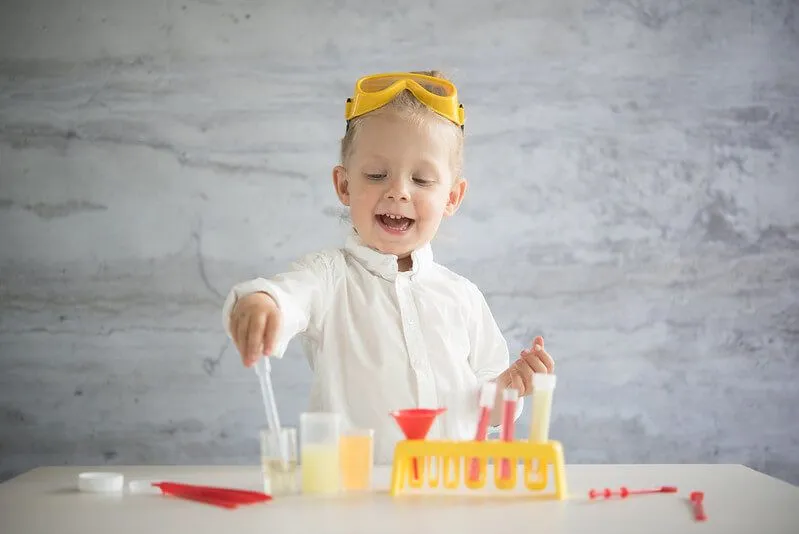FOR ALL AGES
There are lots of ways to make science fun, and designing experiments to do at home is one of the best ways to bring science into everyday life, explaining how the things around us work.
Read on for a quick and easy experiment to try with yeast, which is particularly great if you have been baking or making bread as a family during lockdown! It is yeast that makes the bread dough rise by converting the sugar found in flour into carbon dioxide (CO2) and ethanol (alcohol), through anaerobic respiration. This is the process of 'breathing' without the need for oxygen. The below experiments set out to answer the question 'is yeast alive?', as well as exploring what the perfect amount of sugar is to feed the yeast and how much carbon dioxide is produced.

What You'll Need:
Active dry yeast or baker's yeast
Sugar
Warm water (around 45° C)
Plastic bottle
Method:
1.Measure out a small amount of sugar into different bowls, then add some food colouring into each bowl to create some different coloured sugars. It will be easier to identify which experiment is which later on, and it will help to make the experiment look more appealing to kids.
2.Set up three or four different bowls, each with the same amount of dry yeast and warm water (follow the instructions on the back of the packet regarding quantities).
3.Using the coloured sugars, add different amounts into each yeast and liquid mixture - remember to make a note of how much you used in each bowl.
4.Watch to see what happens to these different mixes, looking for signs of growth or change.
Results:
You should see little bubbles start to rise, or even a foam forming on the top of the mixture, which is caused by carbon dioxide being released by the yeast. Bubbles are a sign that the yeast is alive, and that it is performing anaerobic respiration.
You should notice that the mixtures with too little and too much sugar do not grow, bubble or foam properly. This is because the yeast needs the perfect amount in order to produce carbon dioxide. Photograph the results, or write them down in a table so that you can identify what ratio of yeast to sugar and liquid produces the best bubbles, and perhaps share and/or discuss the results with friends or siblings.

A slightly different set up for the experiment will help visualise that the yeast is 'breathing' .
Method:
1.Using the same ingredients and set up as the first experiment, place the ingredients into a plastic bottle instead of a bowl.
2.Place a balloon over the neck of the bottle.
Results:
After a few minutes, you should start to see the balloon begin to inflate as it fills up with the gas produced by the yeast. Wait to see how large the balloon gets before it stops growing. As a follow-up experiment, why not set up several bottles, and fill each with a different amount of the three ingredients? You can then see which balloon grows the biggest. This way you can work out the optimum quantities of each ingredient - though, as with all experiments, only test one variable at a time.
If the yeast doesn't react as expected, it may be because it has died. Overheating yeast can kill it, meaning that it won't bubble and react when added to water.
Out-of-date or old yeast also might not work. Alive yeast will bubble, and so if you are unsure how old your yeast is, it can be a good idea to do a small test to check before starting any experiments. Simply mix with warm water and see if it bubbles, if it doesn't - you cannot use it. This is useful to know for your experiments, as well as for any baking and making dough.
Read The Disclaimer
At Kidadl we pride ourselves on offering families original ideas to make the most of time spent together at home or out and about, wherever you are in the world. We strive to recommend the very best things that are suggested by our community and are things we would do ourselves - our aim is to be the trusted friend to parents.
We try our very best, but cannot guarantee perfection. We will always aim to give you accurate information at the date of publication - however, information does change, so it’s important you do your own research, double-check and make the decision that is right for your family.
Kidadl provides inspiration to entertain and educate your children. We recognise that not all activities and ideas are appropriate and suitable for all children and families or in all circumstances. Our recommended activities are based on age but these are a guide. We recommend that these ideas are used as inspiration, that ideas are undertaken with appropriate adult supervision, and that each adult uses their own discretion and knowledge of their children to consider the safety and suitability.
Kidadl cannot accept liability for the execution of these ideas, and parental supervision is advised at all times, as safety is paramount. Anyone using the information provided by Kidadl does so at their own risk and we can not accept liability if things go wrong.
Kidadl is independent and to make our service free to you the reader we are supported by advertising.
We hope you love our recommendations for products and services! What we suggest is selected independently by the Kidadl team. If you purchase using the buy now button we may earn a small commission. This does not influence our choices. Please note: prices are correct and items are available at the time the article was published.
Kidadl has a number of affiliate partners that we work with including Amazon. Please note that Kidadl is a participant in the Amazon Services LLC Associates Program, an affiliate advertising program designed to provide a means for sites to earn advertising fees by advertising and linking to amazon.
We also link to other websites, but are not responsible for their content.
Was this article helpful?



Browse Category



We’ll send you tons of inspiration to help you find a hidden gem in your local area or plan a big day out.



Check your inbox for your latest news from us. You have subscribed to:
Remember that you can always manage your preferences or unsubscribe through the link at the foot of each newsletter.